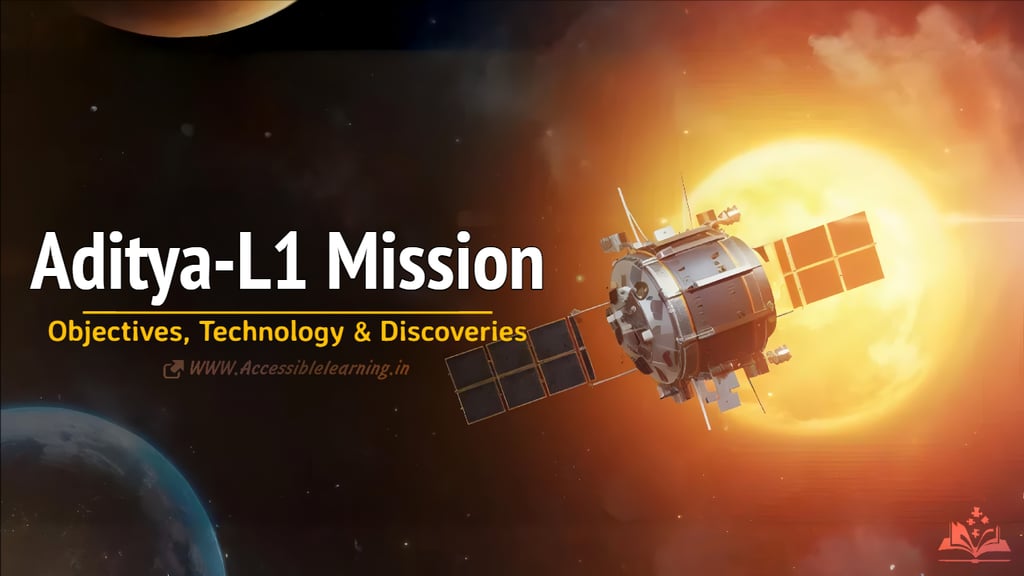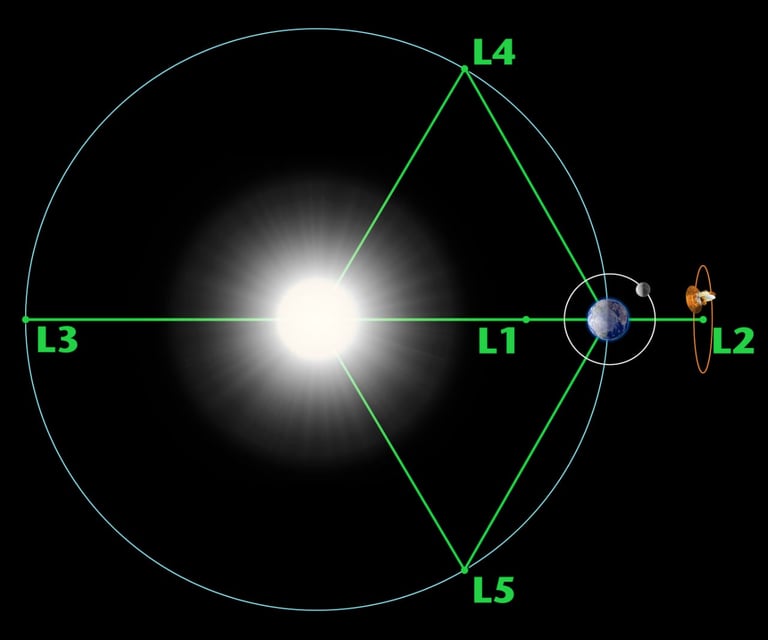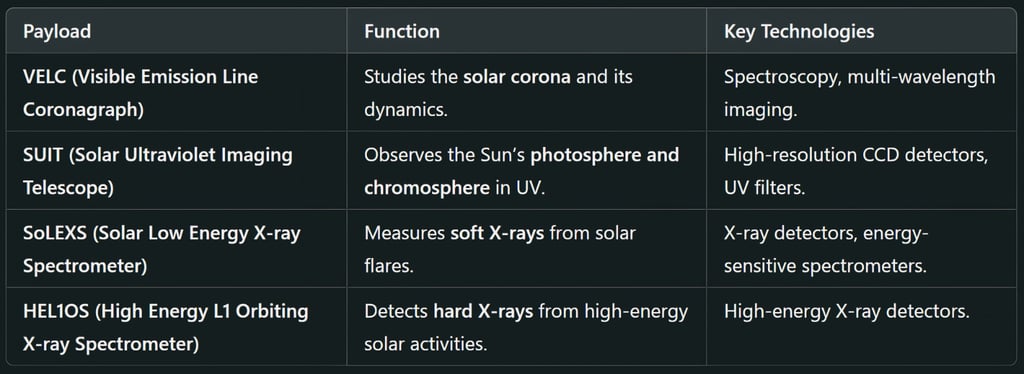
Aditya-L1: India's Historic Solar Mission – Objectives, Technology & Discoveries
Discover Aditya-L1, ISRO's pioneering solar mission, studying the Sun from Lagrange Point 1 (L1). Learn about its payloads, objectives, technical details, challenges, and future implications.
SPACE MISSIONISRO/NASASPACE/TECHEDUCATION/KNOWLEDGE
Keshav Jha
3/21/20254 min read


The Aditya-L1 mission, launched by the Indian Space Research Organisation (ISRO) on September 2, 2023, marks India’s first space-based solar observatory. It is designed to study the Sun from the strategically significant Lagrange Point 1 (L1), about 1.5 million kilometers (932,000 miles) from Earth.
The mission's primary goal is to study solar activities, such as solar flares, coronal mass ejections (CMEs), solar wind properties, and interplanetary magnetic fields, with unprecedented precision.
With seven advanced payloads, Aditya-L1 provides continuous and real-time monitoring of the Sun, a crucial capability for space weather forecasting and satellite protection.
Scientific Objectives: Why Study the Sun?
The Sun influences every aspect of our solar system, including Earth's climate, satellite communications, power grids, and human spaceflight. Aditya-L1 focuses on several key scientific challenges:
Corona Heating Problem
The Sun’s outermost layer, the corona, is hotter than its surface (millions of degrees compared to ~5,500°C on the surface).
The Visible Emission Line Coronagraph (VELC) onboard Aditya-L1 will study this mystery by analyzing the movement of plasma waves and magnetic reconnection events.
Solar Flares and Coronal Mass Ejections (CMEs)
CMEs are massive explosions of magnetized plasma that can disrupt Earth’s power grids and satellite communications.
Aditya-L1’s HEL1OS and SoLEXS instruments will track high-energy X-rays and soft X-rays from these phenomena.
Solar Wind and Its Interaction with Earth
The continuous stream of charged particles (solar wind) from the Sun affects space weather and Earth’s magnetosphere.
Instruments like ASPEX and PAPA will analyze the composition and behavior of solar wind particles.
Interplanetary Magnetic Field (IMF) Variability
The Magnetometer onboard Aditya-L1 will measure variations in the interplanetary magnetic field, helping scientists understand space weather dynamics.


Lagrange Point 1 (L1): The Strategic Location
The Sun-Earth L1 point is 1.5 million km from Earth, where the gravitational forces of the Sun and Earth balance, allowing Aditya-L1 to stay in position without consuming excessive fuel.
🚀 Advantages of L1
Uninterrupted solar observations (No Earth eclipses).
Reduced fuel consumption for station-keeping maneuvers.
Real-time data transmission for space weather forecasting.
🌍 Other Space Missions at L1
Payloads: Advanced Scientific Instruments
Aditya-L1 carries seven payloads, divided into remote sensing and in-situ instruments.




Engineering and Technical Aspects of Aditya-L1
🔧 Spacecraft Configuration
Bus System: Based on ISRO’s IRNSS (NavIC) satellite platform.
Dimensions: 3-axis stabilized satellite with solar panel arrays for power generation.
Thermal Control: Multi-layer insulation (MLI) to protect sensitive instruments from extreme temperatures.
Power System: Solar arrays generating 1.4 kW power.
Communication: X-band telemetry for real-time data transmission to ISRO ground stations.
🚀 Launch and Orbital Maneuvers
Rocket Used: PSLV-C57 (Polar Satellite Launch Vehicle).
Orbit Raising Phases: Multiple Earth-bound orbits before transfer to L1.
L1 Insertion: Achieved through complex trajectory calculations and orbit corrections.
Mission Challenges and Innovations
Navigating to L1: Requires precision orbital maneuvers and fuel-efficient trajectory planning.
Thermal Management: Instruments must withstand solar radiation and extreme temperature fluctuations.
Data Transmission: Real-time communication over 1.5 million km distance with minimal delays.
Instrument Calibration: Ensuring accurate readings over extended mission duration.


Unique Features of Aditya-L1:
VELC Payload: First high-resolution coronagraph onboard a space mission.
Dual X-ray Instruments: Provides both soft and hard X-ray data.
Continuous Observation: Unlike Parker Solar Probe, which flies close to the Sun but has limited observation time.
Future Implications and Potential Discoveries
🌞 Improved Space Weather Forecasting: Early detection of solar storms and CMEs.
🌞 New Insights into Solar Dynamics: Understanding the Sun’s magnetic field evolution.
🌞 Technology Development for Future Missions: Enhanced solar shielding and communication systems.
FAQs
What is Aditya-L1, and why is it important?
Aditya-L1 is India’s first space-based solar observatory, designed by ISRO to study the Sun’s corona, solar flares, coronal mass ejections (CMEs), and solar wind. Positioned at Lagrange Point 1 (L1), it enables continuous observation of the Sun without interruptions from Earth's atmosphere.
How does Aditya-L1 help in space weather forecasting?
The mission monitors solar activities like CMEs and solar flares, which can affect Earth’s satellites, power grids, and communications. By studying these phenomena in real time, Aditya-L1 helps predict space weather events and mitigate their impact on technology and human space missions.
What makes Aditya-L1 different from other solar missions?
Unlike NASA’s Parker Solar Probe, which dives close to the Sun, Aditya-L1 remains at L1, allowing for continuous, long-term solar observations. It also features VELC (Visible Emission Line Coronagraph), one of the most advanced instruments for coronal imaging ever deployed in space.
What are the key instruments onboard Aditya-L1?
Aditya-L1 has seven advanced payloads, including:
VELC: Studies the Sun’s corona.
SUIT: Captures UV images of the Sun.
HEL1OS & SoLEXS: Detect high-energy X-rays from solar flares.
ASPEX & PAPA: Analyze solar wind particles.
Magnetometer: Measures interplanetary magnetic fields.
Why was Aditya-L1 placed at Lagrange Point 1 (L1)?
L1 is a gravitationally stable point about 1.5 million km from Earth, where Aditya-L1 can:
Continuously monitor the Sun without Earth’s shadow.
Use minimal fuel for station-keeping.
Enable real-time space weather observations.
How does Aditya-L1 contribute to India’s space research?
Strengthens India’s position in solar physics and space weather research.
Advances space-based instrumentation and deep-space communication.
Supports future interplanetary missions with solar radiation data.
Aditya-L1 is a groundbreaking mission that places India at the forefront of solar physics research. By providing uninterrupted solar observations, it will contribute valuable scientific data to global space agencies.
🌟 The mission’s success will drive future space endeavors, including deep-space exploration and human missions beyond Earth. 🚀☀️
Subscribe To Our Newsletter
All © Copyright reserved by Accessible-Learning Hub
| Terms & Conditions
Knowledge is power. Learn with Us. 📚


